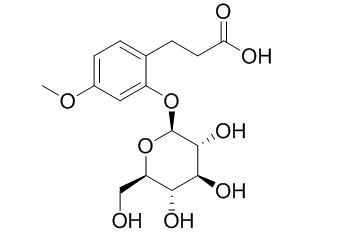3-(2-Glucosyloxy-4-methoxyphenyl)propanoic acid
2-O-beta-d-Glucosyloxy-4-methoxybenzenepropanoic acid[3-(2-Glucosyloxy-4-methoxyphenyl)propanoic acid] exhibits glutathione S-transferase (GST) inhibitory and antifungal activities.
Inquire / Order:
manager@chemfaces.com
Technical Inquiries:
service@chemfaces.com
Tel:
+86-27-84237783
Fax:
+86-27-84254680
Address:
1 Building, No. 83, CheCheng Rd., Wuhan Economic and Technological Development Zone, Wuhan, Hubei 430056, PRC
Providing storage is as stated on the product vial and the vial is kept tightly sealed, the product can be stored for up to
24 months(2-8C).
Wherever possible, you should prepare and use solutions on the same day. However, if you need to make up stock solutions in advance, we recommend that you store the solution as aliquots in tightly sealed vials at -20C. Generally, these will be useable for up to two weeks. Before use, and prior to opening the vial we recommend that you allow your product to equilibrate to room temperature for at least 1 hour.
Need more advice on solubility, usage and handling? Please email to: service@chemfaces.com
The packaging of the product may have turned upside down during transportation, resulting in the natural compounds adhering to the neck or cap of the vial. take the vial out of its packaging and gently shake to let the compounds fall to the bottom of the vial. for liquid products, centrifuge at 200-500 RPM to gather the liquid at the bottom of the vial. try to avoid loss or contamination during handling.
J Anal Methods Chem.2024, 2024:7703951.
Processes2021, 9(5),831.
Pharmaceutics.2023, 15(6):1771.
Eur J Pharmacol.2023, 951:175770.
NanoBioScience2024, v13:3:115.
Journal of Food Engineering2024, 379:112136.
Plants (Basel).2020, 9(11):1555.
FEBS Lett.2021, 595(20):2608-2615.
Cell Physiol Biochem.2019, 52(6):1255-1266
Process Biochemistry2019, 87:213-220
Related and Featured Products
Phytochemistry Letters, 2009, 2(3):106-109.
Bioactive chemical constituents of Caesalpinia bonduc (Fabaceae).[Reference:
WebLink]
METHODS AND RESULTS:
Phytochemical studies on the ethanolic extracts of Caesalpinia bonduc (Fabaceae) yielded two new homoisoflavonoids, caesalpinianone, and 6-O-methylcaesalpinianone along with five known natural products, namely, hematoxylol, stereochenol A, 6′-O-acetylloganic acid, 4′-O-acetylloganic acid, and 2-O-β-d-glucosyloxy-4-methoxybenzenepropanoic acid[3-(2-Glucosyloxy-4-methoxyphenyl)propanoic acid]. Structures of these compounds were elucidated with the aid of extensive NMR spectral studies.
CONCLUSIONS:
All of these compounds exhibited different levels of glutathione S-transferase (GST) inhibitory and antifungal activities.



